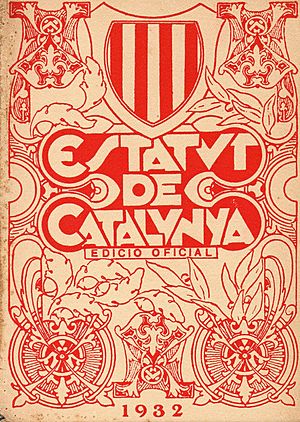Statute of Autonomy of Catalonia of 1932 facts for kids
Quick facts for kids Statute of Autonomy of Catalonia |
|
|---|---|

Front cover of the first Statute of Autonomy of Catalonia, 1932
|
|
| Original title | Estatut d'Autonomia de Catalunya de 1932 |
| Jurisdiction | Catalonia |
| Ratified | 9 September 1932 |
| System | Autonomous parliamentary system under unitary constitutional republic |
| Branches | 3 |
| Chambers | Unicameral (Parliament of Catalonia) |
| Executive | Executive council responsible to the Parliament; President of the Generalitat as head of government |
| Judiciary | Tribunal de Cassació |
| Author(s) | Jaume Carner, Antoni Xirau, Martí Esteve, Rafael Campalans, Pere Coromines |
The Statute of Autonomy of Catalonia of 1932, also known as the Statute of Núria, was a very important law for Catalonia. It was the first time in over 200 years that Catalonia officially gained self-government. This means it could make many of its own decisions.
The Statute was strongly supported by Francesc Macià, who was the President of the Generalitat at the time. People in Catalonia voted on it in a special election called a referendum. A huge 99% of voters said "yes"!
The first draft of this law was finished on June 20, 1931, in a place called Vall de Núria. It was then officially approved by the Spanish Parliament on September 9, 1932. This law was used until 1939, when Catalonia was taken over during the Spanish Civil War.
Contents
A Look Back: Historical Background
In 1931, local elections were held in Spain. These elections showed strong support for parties that wanted a republic, not a king. This led to the creation of the Second Spanish Republic.
In Catalonia, a new political party called the Republican Left of Catalonia (ERC) won by a lot. Their leader, Francesc Macià, then announced the creation of the Catalan Republic. This happened just hours before the Spanish Republic was officially formed. Macià became the temporary leader of this new Catalan Republic.
Talks and Agreements
After three days, some Spanish government ministers visited Macià. They had long talks about the future of Catalonia. Macià agreed to some changes. In return, Catalonia would get its own special law for self-government.
As part of this agreement, the Catalan Republic changed its name to the Generalitat of Catalonia. Macià continued to lead it as its acting president.
How the Statute Was Made
On April 28, 1931, the Spanish government made a rule about how the Generalitat would work. It would have a President, ministers, and a temporary group of representatives. This group was called the Provisional Deputation of the Generalitat.
This group, made up of people from Catalan towns, chose a team to write the new law. The team was led by Jaime Carner. Other members included Antoni Xirau, Rafael Campalans, Martí Esteve, and Pere Coromines.
Drafting and Voting
The first version of the law was finished on June 20, 1931, at a hotel in Vall de Núria.
On August 2, 1931, people in Catalonia voted on this draft law. About 75% of all eligible voters took part. An amazing 99% of them voted "yes"! Also, over 400,000 Catalan women signed their support, even though they couldn't vote yet. This showed how much people wanted this law.
After a small uprising by a general named José Sanjurjo, the Spanish Parliament finally approved the Catalan Statute on September 9, 1932.
What the Statute Said
The first version of the Statute had 52 articles and an introduction. A key idea was that Catalonia would be an autonomous state within the Spanish Republic. It also suggested that the Catalan people might be able to decide their own future later.
The draft law also said that Catalan would be the official language of Catalonia. However, other parts of Spain did not like these ideas. So, some parts of the law were changed.
Changes and Final Approval
The original draft also gave the Generalitat of Catalonia many new powers. These included control over education, health, and public safety. It also allowed for the creation of a Catalan parliament and a high court of justice.
However, when the Spanish Parliament discussed the law, they thought it was too ambitious. They cut down many parts of the original plan.
The final law approved on September 9, 1932, had 18 articles. It described Catalonia as an autonomous region within Spain. It also made Catalan an official language in Catalonia, alongside Spanish.
Putting the Statute into Action
On November 20, 1932, the first election for the Parliament of Catalonia was held. The Republican Left of Catalonia party won most of the seats. Francesc Macià was confirmed as the President of the Generalitat. Lluís Companys became the president of the Parliament.
The Statute of Núria did not last for a very long time. However, the Parliament of Catalonia worked hard to create new laws and strengthen Catalonia's self-government. For example, they passed the Statute of Internal Regime on May 25, 1933.
Suspension and Return
The Statute was suspended after a political group called the CEDA won elections in 1933. It was put back into effect in February 1936 when another group, the Popular Front, won the elections.
However, the Statute was finally ended when the Spanish Civil War finished in 1939. In fact, General Francisco Franco had already ended the Statute in parts of Catalonia he controlled by April 5, 1938.
See also
 In Spanish: Estatuto de autonomía de Cataluña de 1932 para niños
In Spanish: Estatuto de autonomía de Cataluña de 1932 para niños

